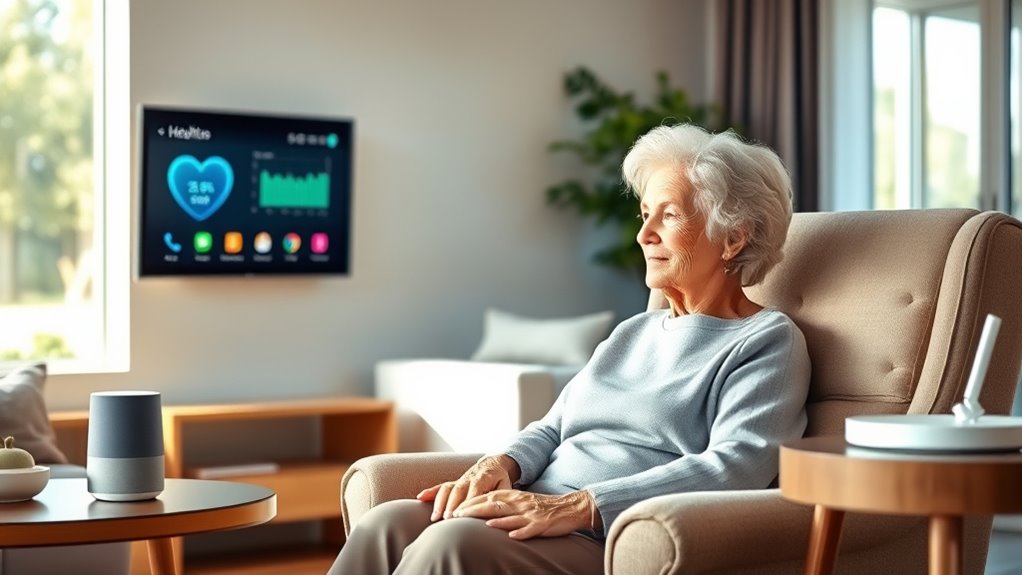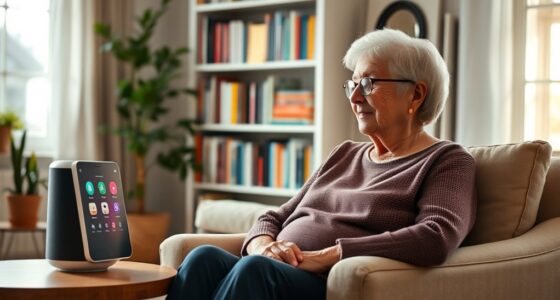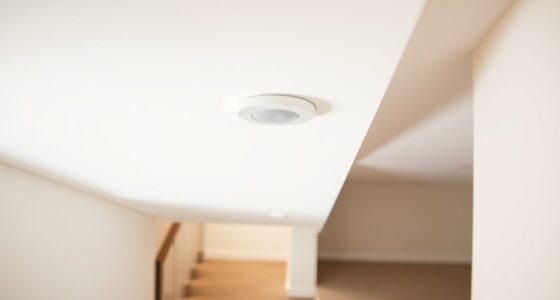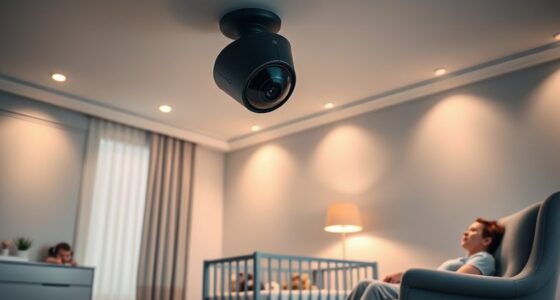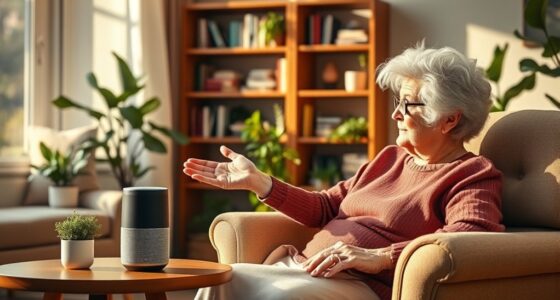Smart devices help you age in place with confidence by offering real-time safety monitoring, fall detection, and seamless home control. You can use sensors, wearable alerts, and voice assistants to stay connected, reduce risks, and respond quickly to emergencies. These innovations support your independence while providing peace of mind for loved ones. If you want to discover how these technologies can enhance your everyday life, keep exploring the options available.
Key Takeaways
- Remote monitoring devices enable caregivers to oversee safety and well-being without intrusion, supporting independent living.
- Fall detection technology automatically alerts emergency services, ensuring quick response after accidents.
- Smart home devices control environment and security systems, enhancing safety and convenience for aging in place.
- Integrated sensors monitor real-time activity and environmental conditions, promoting safety and early issue detection.
- Overall, these smart solutions foster independence, peace of mind, and a safer home environment for seniors.
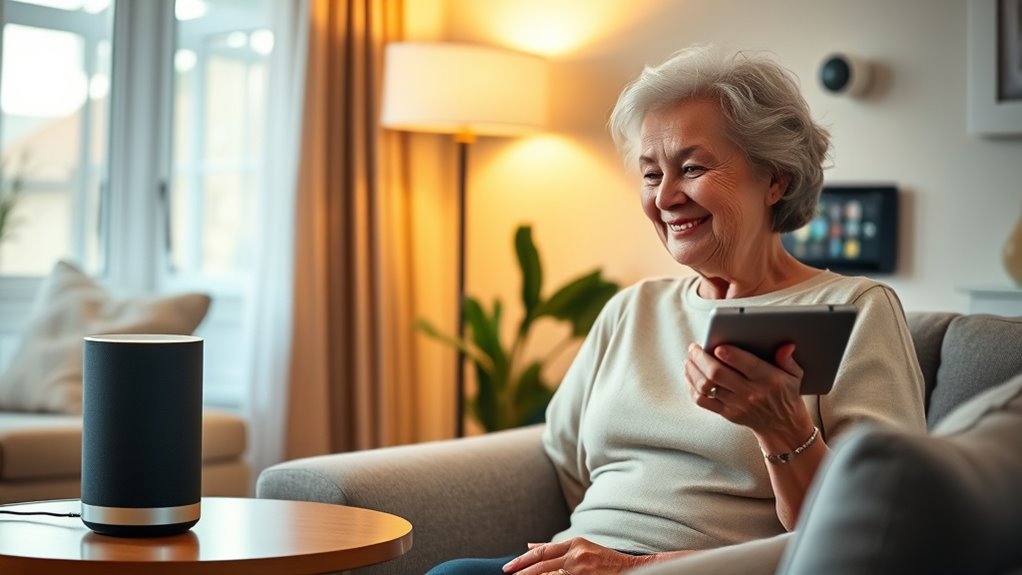
As more seniors choose to age in place, smart devices are transforming how they live independently and safely. These technologies provide peace of mind, allowing you to maintain your routines while ensuring help is always nearby if needed. One of the most impactful innovations is remote monitoring, which enables caregivers or family members to keep an eye on your well-being without intruding on your daily life. Using sensors and connected devices, remote monitoring can track your activity levels, detect unusual patterns, and alert loved ones if something seems off. This approach decodes fan culture by understanding how communities engage with technology to support individual independence. This means you can enjoy your independence, knowing that assistance is just a notification away, whether it’s for medication reminders or checking in on your safety.
Smart devices help seniors live independently by providing remote monitoring and timely alerts for safety and assistance.
Fall detection technology is another essential feature that enhances safety for those aging at home. Falls are a leading cause of injury among seniors, but with fall detection devices, you can minimize the risks. These devices use accelerometers and gyroscopes to identify sudden movements or impacts consistent with a fall. When a fall is detected, an automatic alert is sent to caregivers or emergency services, so help arrives promptly. You don’t need to worry about manually activating an alarm or waiting until someone notices you’re on the floor; these devices work silently in the background, providing reliable emergency response. Many fall detection systems are integrated with wearable devices like pendants or wristbands, making them unobtrusive and easy to wear throughout the day and night.
Beyond fall detection and remote monitoring, smart home devices add another layer of safety and convenience. Voice assistants allow you to control lights, thermostats, and locks simply by speaking, reducing the risk of accidents or situations where reaching for switches might be difficult. Smart doorbells and locks enable you to see and communicate with visitors remotely, enhancing security without leaving your home. Additionally, smart sensors can monitor temperature, humidity, and even detect smoke or carbon monoxide, providing all-encompassing safety coverage.
All these smart devices work together to create an environment where you can confidently live alone, knowing that your safety is actively managed. They empower you to handle daily tasks more easily and respond rapidly to emergencies. With remote monitoring, fall detection, and other smart home features, aging in place becomes not only possible but also more comfortable and secure. You gain independence without sacrificing safety, giving you and your loved ones peace of mind as you continue to enjoy your home on your own terms.
Frequently Asked Questions
Are Smart Devices Affordable for Most Seniors?
You might wonder if smart devices are affordable for most seniors. Prices vary depending on device compatibility and features, but many options are budget-friendly and offer user friendliness, making them accessible. Some basic devices cost less, while more advanced systems may be pricier. Overall, with careful research, you can find smart devices that fit your budget while helping you stay safe and connected at home.
How Secure Is My Personal Data With These Devices?
You might wonder about your data privacy when using smart devices. Generally, these devices prioritize security protocols to protect your personal information, but vulnerabilities can still exist. It’s important to stay informed about how your data is stored and shared. Regularly update device software, use strong passwords, and review privacy settings. While no system is completely foolproof, taking these steps helps guarantee your personal data remains secure.
Can Family Members Access Device Information Remotely?
Imagine your smart device is a secret clubhouse; you might wonder if family members can access it remotely. Usually, these devices allow remote access and device sharing, but you control permissions. You can set up user accounts and restrict access, ensuring only trusted family members can view or manage information. Always check your device’s privacy settings to keep your data secure while allowing remote access for loved ones when needed.
What Is the Average Setup Time for These Smart Devices?
The average setup time for these smart devices varies, but most take about 30 minutes to an hour. During device installation, you’ll find that setup assistance can streamline the process, especially if you’re unfamiliar with tech. Many devices come with step-by-step instructions or remote support options. With patience and some help, you’ll have your smart devices ready quickly, allowing you to enjoy their benefits without lengthy delays.
Are There Any Ongoing Costs Associated With Using These Devices?
Imagine a garden that flourishes with care—your smart devices require ongoing maintenance like regular updates and checks, which can involve some costs. While they help you stay independent, you might face privacy concerns if data isn’t protected properly. These ongoing costs are usually minimal, but staying vigilant about device maintenance and privacy guarantees your smart home remains a safe, reliable sanctuary without unexpected expenses.
Conclusion
Imagine a future where these smart devices seamlessly support your independence, quietly alerting loved ones or emergency services just when you need it most. As technology advances, the line between safety and everyday freedom blurs, offering you peace of mind. Will you embrace these innovations now, or wait until a moment of need makes the choice for you? The path to confident aging is just a device away—are you ready to take the first step?
